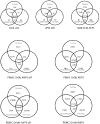A novel algorithm for validating peptide identification from a shotgun proteomics search engine
- PMID: 23402659
- PMCID: PMC3608465
- DOI: 10.1021/pr300631t
A novel algorithm for validating peptide identification from a shotgun proteomics search engine
Abstract
Liquid chromatography coupled with tandem mass spectrometry (LC-MS/MS) has revolutionized the proteomics analysis of complexes, cells, and tissues. In a typical proteomic analysis, the tandem mass spectra from a LC-MS/MS experiment are assigned to a peptide by a search engine that compares the experimental MS/MS peptide data to theoretical peptide sequences in a protein database. The peptide spectra matches are then used to infer a list of identified proteins in the original sample. However, the search engines often fail to distinguish between correct and incorrect peptides assignments. In this study, we designed and implemented a novel algorithm called De-Noise to reduce the number of incorrect peptide matches and maximize the number of correct peptides at a fixed false discovery rate using a minimal number of scoring outputs from the SEQUEST search engine. The novel algorithm uses a three-step process: data cleaning, data refining through a SVM-based decision function, and a final data refining step based on proteolytic peptide patterns. Using proteomics data generated on different types of mass spectrometers, we optimized the De-Noise algorithm on the basis of the resolution and mass accuracy of the mass spectrometer employed in the LC-MS/MS experiment. Our results demonstrate De-Noise improves peptide identification compared to other methods used to process the peptide sequence matches assigned by SEQUEST. Because De-Noise uses a limited number of scoring attributes, it can be easily implemented with other search engines.
Figures







References
-
- Elias JE, Haas W, Faherty BK, Gygi SP. Comparative evaluation of mass spectrometry platforms used in large-scale proteomics investigations. Nat Methods. 2005;2:667–675. - PubMed
-
- Elias JE, Gygi SP. Target-decoy search strategy for increased confidence in large-scale protein identifications by mass spectrometry. Nat Methods. 2007;4:207–214. - PubMed
-
- Peng J, Elias JE, Thoreen CC, Licklider LJ, Gygi SP. Evaluation of multidimensional chromatography coupled with tandem mass spectrometry (LC/LC-MS/MS) for large-scale protein analysis: the yeast proteome. J Proteome Res. 2003;2:43–50. - PubMed
-
- Kall L, Storey JD, MacCoss MJ, Noble WS. Assigning significance to peptides identified by tandem mass spectrometry using decoy databases. J Proteome Res. 2008;7:29–34. - PubMed
-
- Choi H, Nesvizhskii AI. False discovery rates and related statistical concepts in mass spectrometry-based proteomics. J Proteome Res. 2008;7:47–50. - PubMed
Publication types
MeSH terms
Grants and funding
LinkOut - more resources
Full Text Sources
Other Literature Sources

